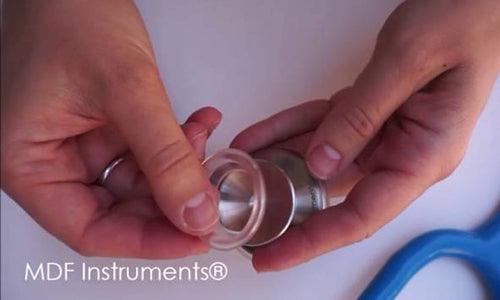Stethoscope Tips
How to use a stethoscope
Are you looking for stethoscope tips for beginners or wondering how to use an MDF Instruments® stethoscope?
How to Wear a Stethoscope
To start, position the stethoscope headset, making sure the eartips are pointing out. MDF Instruments® headsets are designed at a 15 degree forward angle for optimal sound and comfort. MDF Instruments® Ergonomax™ headsets are also adjustable, so feel free to pull apart to loosen or tighten for a more comfortable fit.
Now you are ready to find the best fitting eartips. MDF Instruments® Stethoscopes come fitted with medium eartips on the headset, however we offer ComfortSeal™ soft silicone stethoscope eartips in three sizes, included in the box with every stethoscope. Try all the sizes and choose the best fit for you for comfort and sound. Having eartips that are correctly sized for your ear will help form a tight sound barrier and block out ambient noise. Remember we offer a Free-Parts-For-Life Program that includes these eartips, so you can order your preferred size at any time, for free.
How to Listen with a Stethoscope
The chestpiece will typically have two sides; a larger drum like diaphragm on one side, and an open cone shaped bell with a hole in the center on the other side. The diaphragm is designed to detect higher frequency sounds such as heart beats and breathing noises. The bell will pick up on lower frequency sounds, like certain bowel sounds and heart murmurs.
To make sure you are listening with the correct side of the chestpiece you may tap on the diaphragm to test for sound, or check the green dot indicator on MDF® Stethoscopes. MDF Instruments® Stethoscopes will include a small green dot on the stem of the chestpiece that will face the side of the diaphragm with the open sound channel. To switch between the diaphragm and bell side of the chestpiece, simply rotate the stem and it will lock into place.
Now you are ready to listen. If possible, first try your stethoscope in a quiet room for optimal hearing. Position the chestpiece of the stethoscope on the patient's body adjacent to the heart for example, if you are listening for heart sounds.
If you are having trouble hearing, check the diaphragm of the stethoscope to make sure it is completely closed and there are no gaps between the diaphragm and retaining ring. They should have a tight seal, like a drum.
First time using a stethoscope? You may find it helpful to learn what are the functions of a stethoscope and the different parts that are used for listening and auscultation. Get familiar by checking out our article The Ultimate Guide to All Types of Stethoscopes, plus tips for cleaning and care to make your stethoscope last.
STETHOSCOPES TIPS
WATCH MORE VIDEOS
How to Install a Non-Chill Ring from the Chestpiece of a MDF® Instruments Stethoscope
Has your non chill ring become dirty or cracked? All the free stethoscope parts you need are offered under our Free-Parts-For-Life program! Your non-chill ring is a protector for the low frequency side of your stethoscope. When examining patients, having a cold touch from the chest piece is prevented with the non-chill ring.
Read moreHow to Remove the Non-Chill Ring from the Chestpiece of a MDF® Instruments Stethoscope
It's a great idea to change out your stethoscope parts every once in a while to keep them fresh and hygienic.
Read moreHow to Remove your MDF® Instruments Diaphragm and Retaining Ring from the Chestpiece
Sometimes the diaphragm will crack or get dirty after sometime of use, this is why we offer it under our Free-Parts-For-Life program! We are here to assist with the process to change out your stethoscope parts for fresh ones.
Read moreNewsletter
Sign up to receive 10% off your first purchase!



